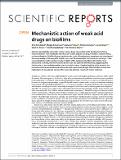Mechanistic action of weak acid drugs on biofilms
Author(s)
Kundukad, Binu; Yang, Kaiyuan; Seviour, Thomas; Yang, Liang; Rice, Scott A.; Kjelleberg, Staffan; Schussman, Megan K.; Doyle, Patrick S; ... Show more Show less
Downloads41598-017-05178-3.pdf (3.719Mb)
PUBLISHER_POLICY
Publisher Policy
Article is made available in accordance with the publisher's policy and may be subject to US copyright law. Please refer to the publisher's site for terms of use.
Terms of use
Metadata
Show full item recordAbstract
Selective permeability of a biofilm matrix to some drugs has resulted in the development of drug tolerant bacteria. Here we studied the efficacy of a weak organic acid drug, N-acetyl-L-cysteine (NAC), on the eradication of biofilms formed by the mucoid strain of Pseudomonas aeruginosa and investigated the commonality of this drug with that of acetic acid. We showed that NAC and acetic acid at pH < pKa can penetrate the matrix and eventually kill 100% of the bacteria embedded in the biofilm. Once the bacteria are killed, the microcolonies swell in size and passively shed bacteria, suggesting that the bacteria act as crosslinkers within the extracellular matrix. Despite shedding of the bacteria, the remnant matrix remains intact and behaves as a pH-responsive hydrogel. These studies not only have implications for drug design but also offer a route to generate robust soft matter materials.
Date issued
2017-07Department
Massachusetts Institute of Technology. Department of Brain and Cognitive Sciences; Massachusetts Institute of Technology. Department of Chemical EngineeringJournal
Scientific Reports
Publisher
Nature Publishing Group
Citation
Kundukad, Binu et al. "Mechanistic action of weak acid drugs on biofilms." Scientific Reports 7 (July 2017): 4783 © 2017 The Author(s)
Version: Final published version
ISSN
2045-2322